Mutation
Cancer is a result of the breakdown of the controls that regulate cells. The causes of the breakdown always include changes in important genes. These changes are often the result of mutations, changes in the DNA sequence of chromosomes. Mutations can be very small changes, affecting only a few nucleotides or they can be very large, leading to major changes in the structure of chromosomes.
Both small and large mutations can affect the behavior of cells. Combinations of mutations in important genes can lead to the development of cancer. The material covered on this page describes the relationship between mutation and cancer, the different kinds of mutations and what causes them. Further information on the topics on this page can also be found in most introductory Biology textbooks, we recommend Campbell Biology, 11th edition.1
Topics on this page:
- Mutation and Cancer
- Inherited Mutations and Cancer
- Types of Mutation
- Causes of Mutation
- Mutation Summary
- Know the Flow: Mutation
Mutation and Cancer
The abnormal behaviors demonstrated by cancer cells are the result of a series of mutations in key regulatory genes. The cells become progressively more abnormal as more genes become damaged. Often, the genes that are in control of DNA repair become damaged themselves, rendering the cells even more susceptible to ever-increasing levels of genetic mayhem.
Below is an animation that demonstrates the relationship between chromosomes, genes and DNA.
Most cancers are thought to arise from a single mutant precursor cell. As that cell divides, the resulting 'daughter' cells may acquire different mutations and different behaviors over a period of time. Those cells that gain an advantage in division or resistance to cell death will tend to take over the population. In this way, the tumor cells are able to gain a wide range of capabilities that are not normally seen in the healthy version of the cell type represented. The changes in behavior seen in cancer cells are the focus of the Cancer Biology section of the site.
Mutations in key regulatory genes (tumor suppressors and proto-oncogenes) alter the behavior of cells and can potentially lead to the unregulated growth seen in cancer.
For almost all types of cancer studied to date, it seems as if the transition from a normal, healthy cell to a cancer cell is a step-wise progression that requires many genetic changes that add up to create the cancer cell. These mutations occur on both oncogenes and tumor suppressors. This is one reason why cancer is much more prevalent in older individuals. In order to generate a cancer cell, a series of mutations must occur in the same cell. Since the likelihood of any gene becoming mutated is very low, it stands to reason that the chance of several different mutations occuring in the same cell is truly very unlikely. For this reason, the cells in a 70 year old body have had more time to accumulate the changes needed to form cancer cells but those in a child are much less likely to have acquired the requisite genetic changes. Of course, some children do get cancer but it is much more common in older individuals. The graph below shows colon cancer rates in the United States as a function of age. The graph was obtained from the National Cancer Institute. 2
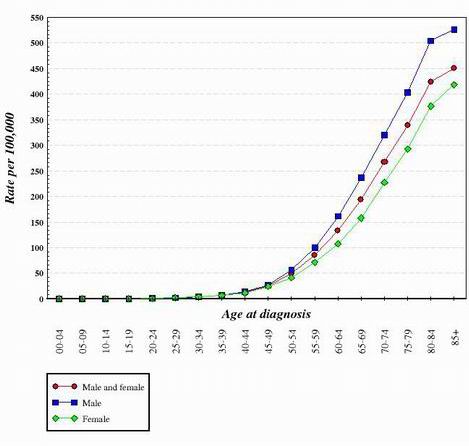
By looking at the shape of curves like the ones shown above, it has been concluded that several genetic changes are required to create cells that become cancerous.
In the laboratory, researchers have been attempting to create tumor cells by altering or introducing key regulatory proteins. Several studies have attempted to define the minimal number of genetic changes needed to create a cancer cell, with intriguing results.3
In nature, mutations can accumulate in cells over time and if the 'right' group of genes are mutated, cancer can result. A 2012 study showed that bone marrow stem cells in a healthy individual accumulate many mutations as the person ages. Just a few more changes to key genes can cause cancer. The results imply that 'normal' cells and cancer cells may not be all that different in many cases.4
Inherited Mutations in Cancer
To complicate matters, it is clear that the changes needed to create a cancer cell can be accomplished in many different ways. Although all cancers have to overcome the same spectrum of regulatory functions in order to grow and progress, the genes involved may differ. In addition, the order in which the genes become de-regulated or lost may also vary. As an example, colon cancer tumors from two different individuals may involve very different sets of tumor suppressors and oncogenes, even though the outcome (cancer) is the same.
The great heterogeneity seen in cancer, even those of the same organ, means that diagnosis and treatment are complicated. Current advances in the molecular classification of tumors should allow the rational design of treatment protocols based on the actual genes involved in any given case. New diagnostic tests may involve the screening of hundreds or thousands of genes to create a personalized profile of the tumor in an individual. This information should allow for the tailoring of cancer treatments geared to the individual. For more information on this see theGenomics/Proteomics section.
The genetic changes that lead to unregulated cell growth may be acquired in two different ways. It is possible that the mutation can occur graduallyover a number of years, leading to the development of a 'sporadic' case of cancer. Alternatively, it is possible to inherit dysfunctional genes leading to the development of a familial form of a particular cancer type. Some examples of cancers with known hereditary components include:
- Breast cancer- Inheritance of mutant versions of the BRCA1 and BRCA2 genes are known risk factors. Although many, if not most, individuals with breast cancer do nothave detectable alterations in these genes, having a mutant form increases the likelihood of developing breast cancer.
- Colon cancer- Defects in DNA repair genes such as MSH2 are known to predispose individuals to hereditary non-polyposis colorectal cancer (HNPCC).
- Retinoblastoma- Defects in the Rbtumor suppressor gene are known to cause this eye cancer and several other types of cancers. More on this particular disease can be found in the section on Rb
This is an incomplete list of the known inherited cancer types, and it is certain that more inherited forms of cancer will identified as the genetics of various types of cancer are clarified.
More information on this topic may be found in Chapters 2 and 4 of The Biology of Cancer by Robert A. Weinberg.
Types of Mutation
The process by which proteins are made,translation, is based on the 'reading' of mRNA that was produced via the process of transcription. Any changes to the DNA that encodes a gene will lead to an alteration of the mRNA produced. In turn, the altered mRNA may lead to the production of aprotein that no longer functions properly. Even changing a single nucleotide along the DNA of a gene may lead to a completely non-functional protein.
There are several different ways DNA can be altered. The following section describes the different types of genetic change in more detail.
Point Mutations
Genetic alterations can be placed into two general categories. The first category is comprised of changes that alter only one or a few nucleotides along a DNA strand. These types of changes are termed point mutations.
When ribosomes read a messenger RNA molecule, every three nucleotides is interpreted as oneamino acid. These three letter codes are called codons. To make an analogy to an English sentence: 'The fat cat ate the rat' would contain 6 codons. The changes caused by mutation can lead to things like 'The fat bat ate the rat.' or 'The fa' or 'The fat oca tat her at...' The impact on the protein depends on where the change occurs and the kind of change.
The three-letter codons read by ribosomes may be changed by mutation in one of three ways:
Nonsense mutations
The new codon causes the protein to prematurely terminate, producing a protein that is shortened and often does not function properly or at all.
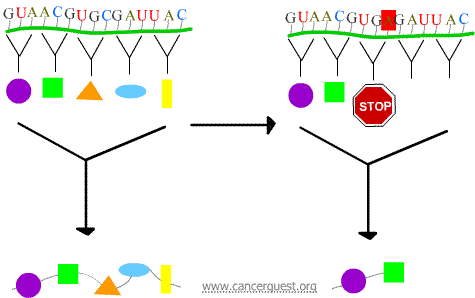
Missense mutations
The new codon causes an incorrect amino acid to be inserted into the protein. The effects on the function of the protein depend on what is inserted in place of the normal amino acid.

Frameshift mutations
The loss or gain of 1 or 2 nucleotides causes the affected codon and all of the codons that follow to be misread. This leads to a very different and often nonfunctional protein product.
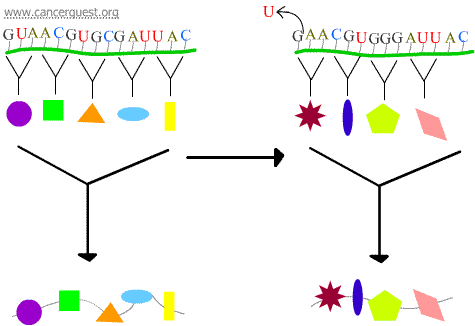
Some DNA damage results in a modified nucleotide or small group of nucleotides that can not be 'read' by RNA polymerase. When the RNA polymerase complex reaches these spots they will sometimes bypass the damage by adding in nucleotides in an effort to continue going, even if it means putting in the wrong thing. This process is known as transcriptional mutagenesis and it may play a significant role in the development of cancer.5
Translocations
Another category of mutations involves alterations of larger amounts of DNA, often at the level of thechromosome. These are called translocations and involve the breakage and movement of chromosome fragments. Often, breaks in two different chromosomes allow for the formation of two 'new' chromosomes, with new combinations of genes.
While it might appear that this would not cause much trouble, since all the genes are still present, the process can lead to deregulated cell growth in a number of ways-
1. The genes may not be transcribed and translated appropriately in their new location.
2. The movement of a gene can lead to an increase or a decrease in its level of transcription.
3. The breakage and rejoining may also occur within a gene (as shown in green above), leading to its inactivation.
1. The genes may not be transcribed and translated appropriately in their new location.
2. The movement of a gene can lead to an increase or a decrease in its level of transcription.
3. The breakage and rejoining may also occur within a gene (as shown in green above), leading to its inactivation.
For some cancers, particular translocations are very common and may even be used in diagnosing the disease. Translocations are common in leukemias and lymphomas and have been less commonly identified in cancers of solid tissues. An example would be an exchange between chromosomes 9 and 22 seen in over 90% of patients with chronic myelogenous leukemia (CML). The exchange leads to the formation of a shortened form of chromosome 22 called the Philadelphia chromosome (after the location of its discovery). This translocation leads to the formation of an oncogene from the abl proto-oncogene.67
Other cancers that are often (or always) associated with particular translocations include Burkitt's lymphoma, B-cell lymphomas and several types of leukemia.
Gene Amplification
In this very unusual process, the normal DNAreplication process is seriously flawed. The result is that instead of making a single copy of a region of a chromosome, many copies are produced. This leads to the production of many copies of the genes that are located on that region of the chromosome. Sometimes, so many copies of the amplified region are produced that they can actually form their own small pseudo-chromosomes called double-minute chromosomes.
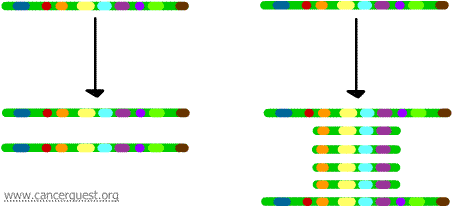
The genes on each of the copies can be transcribed and translated, leading to an overproduction of the mRNA and protein corresponding to the amplified genes as shown below. The squiggly lines represent mRNA being produced via the transcription of each copy of the gene.
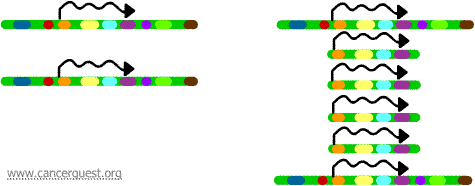
While this process is not seen in normal cells, it occurs quite often in cancer cells. If an oncogene is included in the amplified region, then the resulting overexpression of that gene can lead to deregulated cell growth. Examples of this include the amplification of the myc oncogene in a wide range of tumors and the amplification of the ErbB-2 or HER-2/neu oncogene in breast and ovarian cancers. In the case of the HER-2/neu oncogene,clinical treatments have been designed to target cells overexpressing the protein product.
Gene amplification also contributes to one of the biggest problems in cancer treatment: drug resistance. Drug resistant tumors can continue to grow and spread even in the presence ofchemotherapy drugs. A gene commonly involved is called MDR for multiple drug resistance. The protein product of this gene acts as a pump located in the membrane of cells. It is capable of selectively ejecting molecules from the cell, including chemotherapy drugs. This removal renders the drugs ineffective.
This is discussed in more detail in the section onDrug Resistance. The amplification of different genes can render other chemotherapy drugs ineffective.
Inversions, Duplications, and Deletions
Inversions
In these alterations, segments of DNA are released from a chromosome and then re-inserted in the opposite orientation. As in the previous examples, this rearrangement can lead to abnormal gene expression, either by activating an oncogene or de-activating a tumor suppressor gene.
Duplications/Deletions
Through replication errors, a gene or group of genes may be copied more than one time within a chromosome. This is different from gene amplification in that the genes are not replicated outside the chromosome and they are only copiedone extra time, not hundreds or thousands of times. Genes may also be lost due to failure of the replication process or other genetic damage.

Aneuploidy
Aneuploidy is the genetic change that involves the loss or gain of entire chromosomes. Due to problems in the cell division process, the replicated chromosomes may not separate into the daughter cells accurately. This can result in cells that have too many chromosomes or too few chromosomes. An example of a fairly common aneuploid condition that is unrelated to cancer is Down syndrome, in which there is an extra copy of chromosome 21 in all of the cells of the affected individual.
In the animation below, copies of two chromosomes are made but when the cell divides the chromosomes are not distributed evenly to the two cells that are formed (daughter cells). The result is that one of the cells has too many chromosomes and one does not have enough.
Cancer cells are very often aneuploid. Humans normally have 46 chromosomes in their cells, but cancer cells often have many more, sometimes greater than100. The presence of the extra chromosomes makes the cells unstable and severely disrupts the controls on cell division. There is currently an ongoing debate as to whether or not all cancers are aneuploid. Regardless of whether that is the case, it is clear that aneuploidy is a common feature of cancer cells.
Epigenetic Changes
In addition to actual alterations in DNA sequence,gene expression can be altered by changes to the DNA and chromatin that do not change the sequence. Since these changes do not alter the sequence of the DNA in the genes, they are termed epigenetic changes. Two types of epigenetic changes are described below.
Methylation
In this alteration, some nucleotides in the DNA are modified by the addition of a methyl (-CH3) group to the base. Methylation of DNA is associated with the inactivation of that particular region of DNA. Abnormal DNA methylation patterns have been seen in cancer cells. Like the changes described, methylation alters the expression of the affected genes.
Acetylation
In this epigenetic change, the histone proteins around which the DNA is wound become modified by the addition of acetyl (-CH3CHO) groups. This alteration leads to a loosening of the DNA:histone interaction and is associated with increased gene expression. The modification of the processes of addition and removal of acetyl groups to DNA is an active area of cancer treatment research.
Causes of Mutation
As we have seen, cancer cells are created from normal precursor cells via an accumulation of genetic damage. The mechanisms by which the changes are induced is varied. In a broad sense, the agents of genetic change (mutation) fall primarily into the categories described below and are discussed in depth in the following section.
Spontaneous Mutations
Spontaneous mutations: The bases (A, T, G, C) in DNA are altered or lost due to unrepairedreplication errors or random molecular events. For example, the loss of an amino group from cytosine, a normal base found in DNA, leads to the production of uracil, a base not normally found in DNA. If this change is not detected and reversed, a mutation can result. Occasionally, an entire base can be lost as a result of the cleavage of the bond between the DNA backbone and the base. This leads to a gap in the DNA double-helix, which, if not repaired, can lead to a mutation the next time the DNA is copied (i.e. during replication).
Induced Mutations
Induced mutations: Mutations can be induced by exposing organisms (or cells) to a variety of treatments. Some of the most common are:
Radiation- One of the first known mutagens, radiation is a potent inducer of mutations. Different types of radiation cause different types of genetic changes. Ultraviolet (UV) radiation causes point mutations. X-rays can cause breaks in the DNA double-helix and lead to translocations, inversions and other types of chromosome damage. Exposure to the UV rays in sunlight has been linked to skin cancer. Note that the DNA damaging properties of radiation have been utilized in several different radiation-based cancer treatments.
Shown below is a type of mutation that is caused by ultraviolet radiation. In this example, the bombardment of the DNA double-helix by UV rays causes two bases to join together. This alters the structure of the DNA and can lead to permanent changes if not repaired.
Shown below is a type of mutation that is caused by ultraviolet radiation. In this example, the bombardment of the DNA double-helix by UV rays causes two bases to join together. This alters the structure of the DNA and can lead to permanent changes if not repaired.
Another type of radiation is the energy emitted by naturally occuring radioactive elements (like radon and uranium) or man-made sources like those found (and created) in nuclear reactors. Radiation of this type comes in different types and can cause different types of damage to cells and tissues. Radiation can directly damage DNA or can cause the formation of chemicals (i.e. reactive oxygen species or ROS) that can then damage DNA or other cell components.
Exposure to radiation from radioactive materials has been well documented. Analyses of survivors of the atomic bombs dropped on Japan during World War II showed large increases in leukemias shortly after the exposure and then increases in other cancer types over the following decades.8
Dangerous amounts of radioactive materials have also been accidentally released from nuclear power plants. Radiation exposure due to the accidental release of radioactive materials from the Chernobyl nuclear reactor have been associated with increases in thyroid cancer and other malignant cancers.9
Medical imaging machinery (like X-ray machines and CT scanners) also expose patients to radiation. The amounts used for any single test are not thought to cause siginificant amounts of cancer, but the long term impact of many tests over a period of years is not clear.10 Likewise, the exposure of airplane passengers to full-body scans at airports is not thought to pose a risk of cancer.11 Passengers flying in planes are also exposed to radiation from space, but at a low level and is not thought to pose a cancer risk, even for flight crew members.1112
Chemical mutagens- Many different chemicals are known to cause mutations. These chemicals exert their effect by binding to DNA or the building blocks of DNA and interfering with the replication or transcription processes. Some examples of potent mutagens are benzo-a-pyrene, a chemical found in cigarette smoke, and aflatoxin, amutagen most often found on improperly stored agricultural products.
Chronic inflammation- Chronic inflammation can lead to DNA damage due to the production ofmutagenic chemicals by the cells of the immune system. An example would be the long-term inflammation caused by infection with the hepatitis virus. Learn more about viruses and cancer.
Oxygen Radicals- During the capture of energy from food, which occurs in our mitochondria, chemicals may be generated which are very reactive and are capable of damaging cell membranes and DNA itself. These reactive oxygenintermediates (ROI) may also be generated by exposure of cells to radiation, as shown below.
The mutagenic activity of ROI is associated with the development of cancer as well as the activities of several anticancer treatments, including radiation and chemotherapy. 131415
Abnormal Cell Division
During mitosis, it is possible that the cell division process fails to divide the replicated chromosomes accurately into two daughter cells. An error of this type will lead to the production of aneuploid cells. The cells will either be missing, or have gained a significant number of genes. This rare process can create cells that are more prone to unregulated cell division. As stated previously, a large percentage of cancers isolated from humans are aneuploid.
If a cell has a mutation in a gene whose protein product is responsible for 'checking' on the division process, things can rapidly get out of control and the daughter cells of each division can become increasingly abnormal.
Viruses as Mutagens
Viruses are thought to be responsible for a significant percentage of cancer cases. Viruses can cause cancer in a variety of ways and the way that each type of virus works is likely to be slightly different. Some viruses (including many retroviruses) can cause mutations by inserting their genes into the genome of the infected cell. The inserted DNA can destroy or alter the activity of affected genes.161718
Viruses can also cause mutations in indirect ways. As an example: An infection with hepatitis virus can last for many years. During that time the body's defense system tries to get rid of the virus by producing toxic chemicals. Those chemicals can cause damage to otherwise healthy 'bystander' cells, sending them down the road that leads to cancer. There are numerous other ways that viruses can cause cancer.1920
Because of the importance of viruses in the development of many cancers we have created a section devoted to viruses and cancer.
Transposons as Mutagens
Transposons are short DNA sequences that have the ability to move from one location in DNA to another location. Transposons encode anenzyme, transposase, that acts to splice the transposon into new locations in a genome (see schematic, below left, of a transposon) Transposons were discovered by Barbara McClintock and she won a Nobel prize for her work.2122 The human genome contains many inactivated copies of transposons that have lost their ability to move or 'jump' to new locations. About 50% of the human genome is composed of 'dead' transposons.23
The movement of active transposons can lead to mutations, alterating the activity of genes. A visible example of transposon movement (called transposition), is the coloration of the kernels in Indian corn (see below right). The transposons that are active in humans are thought to be involved in human disease, including cancer.242526









No comments:
Post a Comment